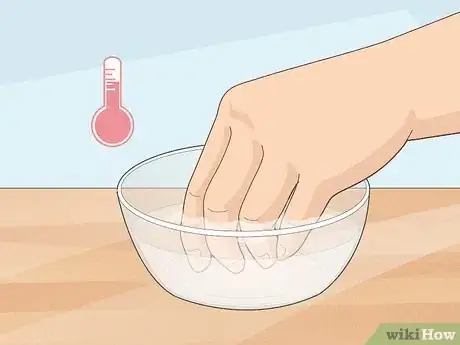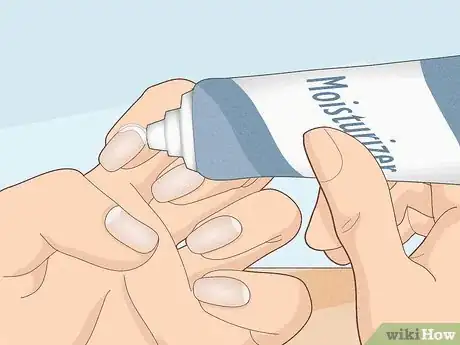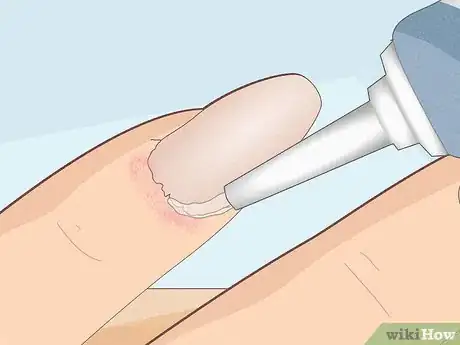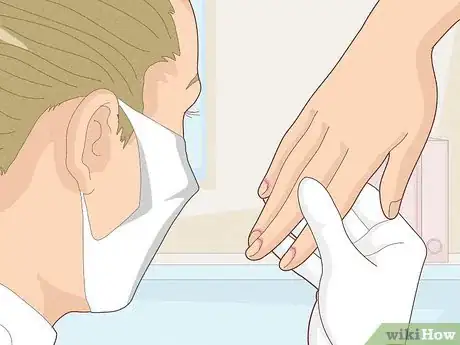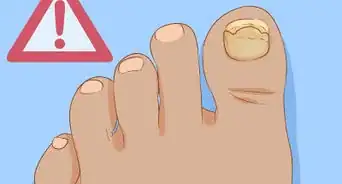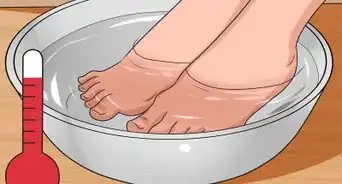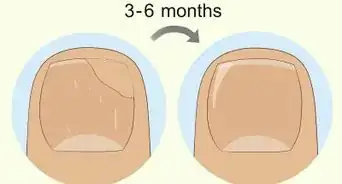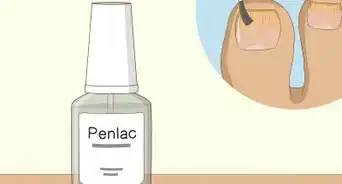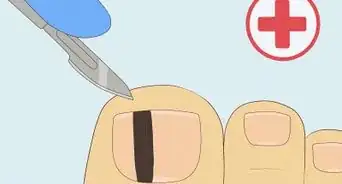This article was co-authored by Kristin Pulaski and by wikiHow staff writer, Megaera Lorenz, PhD. Kristin Pulaski is a Professional Nail Artist and the Founder of Paintbucket, a self-owned and operated nail salon based in Williamsburg, Brooklyn. She has over five years of experience running Paintbucket and is licensed as a nail technician. Paintbucket offers nail art manicures, pedicures, and soft gel extensions along with customized packages for wedding and bridal parties. She holds a BA in Managerial Science from Manhattan College.
wikiHow marks an article as reader-approved once it receives enough positive feedback. This article received 26 testimonials and 100% of readers who voted found it helpful, earning it our reader-approved status.
This article has been viewed 2,678,979 times.
Dry, peeling cuticles can be quite painful and look unsightly. Luckily, this is one problem you can solve without too much time or effort—you just need to be prepared to give your hands a little TLC. You can treat your dry cuticles by adding moisture and caring for them. Fortunately, you can also prevent peeling cuticles!
Things You Should Know
- Moisturize your cuticles regularly to keep them in great shape.
- Push your cuticles back with an orange stick instead of cutting them.
- Treat any cracked or painful cuticles with a topical antibacterial ointment.
- Prevent dry cuticles by wearing gloves, avoiding drying agents, eating healthy foods, and staying hydrated.
Steps
Moisturizing Your Cuticles
-
1Make a homemade cuticle treatment. If you have the time, you can make a really effective cuticle treatment at home using some hand cream and oils. Here's how:
- In the microwave, warm up a bowl of 1⁄3 cup (79 mL) hand cream, a few glugs of olive oil (or grape seed oil, if you have it), and 3-4 drops of lavender oil (found in the health food store) to a temperature that is warm but not too hot to touch.
- Apply a generous amount to each fingernail and gently massage into the nail, cuticle, and surrounding skin, spending a minute or two on each. The cream is extremely good for your hands (and feet!) and will keep your cuticles soft.
- You can keep and re-warm this homemade cream for up to 3 days in your fridge if you store it in a dark glass bottle.
-
2Use olive oil for quick, easy results. Olive oil is an excellent moisturizer, which you can use on its own to treat your cuticles. Dab a small amount on each cuticle using either the pad of your fingertip or a moistened cotton swab. Massage the oil into each cuticle for 1-2 minutes. Then, allow the oil to soak in before you wash your hands.
- You can use the same olive oil you use for cooking.
Advertisement -
3Get a hot wax treatment. If you can afford it, investing in a hot wax treatment at your local nail salon can work wonders for hands, nails, and cuticles.
- During a hot wax treatment, the technician will apply a cream or oil to your hands. Then, they'll coat your hands in melted paraffin wax. Immediately after, you will put on a pair of plastic gloves and place your hands in a mitt.
- After 10 to 15 minutes, you will remove your hands from the mitt, and the technician will remove the wax, leaving the skin of your hands and cuticles feeling soft and supple.[1]
- It is also possible to buy paraffin wax treatment kits online, which you can use at home.
-
4Use petroleum jelly to seal in moisture. While it's not a moisturizer, petroleum jelly seals in your natural moisture and protects your skin from the environment. You can also use it after your hand cream to seal in the moisture. Petroleum jelly will soften your cuticles and stop them from peeling, but it will also be very greasy. Make sure you thoroughly wash your hands before you eat or drink anything.
- Although petroleum jelly is best used with another product, it is a cheap alternative. You can get a giant tub at a low cost.
-
5Try essential oils. Essential oils can be helpful in moisturizing your cuticles, while also smelling great! To moisturize your nails, try jojoba[2] or sesame oil, or lemon, lavender, myrrh, frankincense, balsam fir, or wintergreen essential oil. You can also use tea tree oil to keep your nails clean and prevent infection.
- In most cases, you'll need to dilute your essential oils with a carrier oil, as they're too concentrated to be used directly on your skin. Great carrier oils include olive, grapeseed, or coconut oil.
-
6In a pinch, use some lip balm. If you're out and about and your cuticles are bothering you, have a look in your bag for a stick of lip balm and try rubbing a little on your cuticles. It should provide some temporary relief until you can get your hands on some hand cream.
Caring For Your Cuticles
-
1Soak your fingertips in hot water. Give your hands a soak in hot (not boiling) water or take a long bath. This will help to soften the cuticles and any loose skin. If you like, you can add 1 teaspoon (4.9 mL) of freshly-squeezed lemon juice or vinegar to the water. This will help to exfoliate any dead skin.
-
2Push back your cuticles with an orange stick. Once your cuticles have been softened, it should be easy to push them back using an orange stick.
- An orange stick is a small wooden or metal stick used to push back cuticles and clean under the nails. They can be purchased cheaply at the drug store, beauty supply store, or online.
- Use the flat end of the orange stick to push back the cuticle. Try to do this very gently—if you push too hard you might hurt yourself and make your cuticles worse!
- Push the cuticles back until you can see the white half-moon shape (called the lunula) at the bottom of each fingernail. Don't do this more than once or twice a month, as the cuticles are quite sensitive.
- Metal or plastic orange sticks need to be sterilized after each use, while wooden orange sticks should be thrown away.[3]
-
3Never cut your cuticles. Your cuticles are important - they protect your nail's growth matrix (the part the nails grow from) by preventing any dirt or bacteria from entering. As a result, you should refrain from cutting your cuticles and switch to pushing them back instead.
- Cutting your cuticles removes this protective layer and exposes your nails to infection. It also makes the skin of the cuticles harder and more prone to splitting and peeling.
- Don't worry about your cuticles growing back faster once you stop cutting them—this is a myth. Their rate of growth will remain the same even if you stop cutting.[4]
-
4Regularly moisturize your cuticles. Regularly moisturizing your cuticles is one of the most important steps in stopping your cuticles from peeling. Moisturize them at least twice a day—once in the morning and once at night.
- Don't forget that your cuticles are made out of skin (despite their thicker texture), and all skin needs to be moisturized in order to stay hydrated and prevent peeling and flaking.
- During the day you can use a moisturizing hand lotion that soaks in quickly and doesn't leave your hands feeling greasy. At night, however, you might opt for a thicker cream or cuticle ointment for more intense hydration.
- After you moisturize your hands and cuticles at night, it is a good idea to wear a pair of cotton or wool gloves to bed. This prevents the cream or ointment from rubbing off on the bed sheets, while the extra heat will help your skin to really absorb the moisturizer. You will wake up in the morning with really soft hands and cuticles!
-
5If your cuticles are cracked and painful, use a topical antibacterial ointment. If the skin around your fingernails feels cracked and irritated, you may have a small infection. If this is the case, you will need to clear up the infection before your cuticles can start to heal.
- You can do this by applying a generous layer of topical antibacterial ointment (such as Neosporin) to the cuticles.
- Once you have applied the antibacterial ointment (which is more effective than the cream version), wrap a band-aid around each affected nail.
- Leave the band-aid on overnight and in the morning, you will find your cuticles looking and feeling a lot better!
-
6Know when to consult a doctor. If your cuticles are painful, have pus or swelling, or develop red spots, you may have an infection called paronychia. If you suspect this could be the case, see your doctor as soon as possible as you may require a course of antibiotics to clear the infection.
Preventing Dry Cuticles
-
1Protect your hands from cold weather. Cold weather can be very drying to your hands, causing cuticles to crack and peel.
- Therefore, it is important to pay special attention to protecting your hands in wintertime, or whenever you are experiencing very cold weather.
- Always wear gloves when you are outdoors and remember to carry hand cream in your bag or pocket that you can apply at regular intervals.
-
2Keep your fingers away from your mouth. People who tend to bite their nails or nibble at their cuticles are much more likely to develop dry, peeling skin around their fingers than those who don't.
- You are also at risk of developing an infection, as your mouth contains bacteria that can easily transfer to your nails. Saliva also contains enzymes that break down the skin, leading to further dryness.
- Therefore, one of the most effective measures you can take to prevent dry, peeling cuticles is to stop biting and keep your hands away from your mouth.
- To help you, you can purchase special foul-tasting ointments for your nails. They make your fingers taste so bad that you'll think twice before biting again!
-
3Avoid drying agents. Having dry hands can accelerate the cracking and peeling of cuticles, so make sure to protect them from any unnecessary exposure to drying agents.
- Frequently washing the dishes in hot, soapy water can be very drying for your hands, so protect them by wearing rubber gloves every time you do the washing up.
- If you don't like wearing the gloves, then at least invest in a more moisturizing dish soap designed to hydrate your hands as you wash. When your nails get wet, make sure they dry thoroughly.
- Steer clear of acetone-based nail polish removers, as these sap moisture from your nails like nobody's business. You should also try to keep hand washing to a minimum, as frequent washing removes important natural oils from the surface of the skin and nails.
-
4Eat a healthy diet. A healthy, balanced diet will provide the vitamins and minerals your body needs for healthy hair, skin, and nails. Your cuticles will be moist, and your nails will grow more quickly. Eat lots of vegetables and fruits, choosing organic options when you can.[5]
- To strengthen your nails, eat more eggs, almonds, strawberries, chicken, flaxseed oil, coconut oil, lentils, watermelon, bell peppers, and whole grains.[6]
-
5Stay hydrated. Just as staying hydrated keeps your skin moist, it can also help keep your cuticles healthy. Drinking at least 8 glasses of water daily will help moisturize your cuticles, preventing dryness.[7]
- If you are very active, drink more water!
- Carry around a reusable water bottle to make it easier for you to drink water on the go.
-
6Choose your manicurists carefully. Be careful when choosing a nail technician for your manicures and pedicures, as a poorly executed manicure can do more harm than good.
- Some nail technicians can be very rough with your nails and cuticles, which can result in peeling, cracking, and soreness.
- If your nail technician tries to cut your cuticles, or tries to push your cuticles back too far, politely ask her to stop. They're your nails, so you get to decide what happens to them.
- If your nail technician cuts your cuticles and you end up with soreness or an infection, this could be the result of improperly sterilized equipment. If this happens, you should consider switching to a different nail salon.
Expert Q&A
-
QuestionWhy is the skin peeling off my fingertips?
 Laura MartinLaura Martin is a Licensed Cosmetologist in Georgia. She has been a hair stylist since 2007 and a cosmetology teacher since 2013.
Laura MartinLaura Martin is a Licensed Cosmetologist in Georgia. She has been a hair stylist since 2007 and a cosmetology teacher since 2013.
Licensed Cosmetologist It could be old calluses that are coming loose. It could also be a reaction to strong chemicals. It's hard to know without more information.
It could be old calluses that are coming loose. It could also be a reaction to strong chemicals. It's hard to know without more information. -
QuestionWhat vitamin deficiency causes skin to peel?
 Laura MartinLaura Martin is a Licensed Cosmetologist in Georgia. She has been a hair stylist since 2007 and a cosmetology teacher since 2013.
Laura MartinLaura Martin is a Licensed Cosmetologist in Georgia. She has been a hair stylist since 2007 and a cosmetology teacher since 2013.
Licensed Cosmetologist Niacin deficiency can cause skin to peel. You can also have skin peeling or cracking as the result of getting too much vitamin A.
Niacin deficiency can cause skin to peel. You can also have skin peeling or cracking as the result of getting too much vitamin A. -
QuestionWhy is the skin under my fingernails peeling?
 Laura MartinLaura Martin is a Licensed Cosmetologist in Georgia. She has been a hair stylist since 2007 and a cosmetology teacher since 2013.
Laura MartinLaura Martin is a Licensed Cosmetologist in Georgia. She has been a hair stylist since 2007 and a cosmetology teacher since 2013.
Licensed Cosmetologist The skin could be dry or it could be an allergic reaction. Try applying some lip balm or coconut oil for long-lasting, water-resistant moisture.
The skin could be dry or it could be an allergic reaction. Try applying some lip balm or coconut oil for long-lasting, water-resistant moisture.
Warnings
- Make sure you really investigate the salons where you go get your nails done. Be a service-savvy client. Ask how implements are cleaned.⧼thumbs_response⧽
- Never remove the cuticles completely or allow somebody to remove them completely.⧼thumbs_response⧽
References
- ↑ 2.02.1http://www.webmd.com/beauty/nails/caring-for-your-cuticles
- ↑ https://pubmed.ncbi.nlm.nih.gov/24442052/
- ↑ http://www.wisegeek.org/what-is-an-orange-stick.htm
- ↑ https://www.glamour.com/story/best-nail-tips-how-to-grow-out-your-nails
- ↑ https://www.eatthis.com/foods-for-stronger-hair-nails/
- ↑ https://www.instyle.com/news/6-amazing-beauty-benefits-drinking-enough-water
About This Article
When your cuticles are dry, they can start to peel and crack. To stop your cuticles from peeling, remember to moisturize your hands with lotion every day. You can also apply cuticle cream or oil directly to your cuticles to moisturize them. Coconut oil or olive oil work as an easy DIY cuticle moisturizer. To prevent your cuticles from drying out, wear gloves when washing dishes since hot, soapy water is very drying. You should also avoid acetone nail polish remover for the same reason. If nothing seems to help, talk to your doctor since peeling cuticles can be caused by conditions like eczema and medication may be able to help. To learn more from our Cosmetologist co-author, such as how to prevent getting dry cuticles, keep reading!






